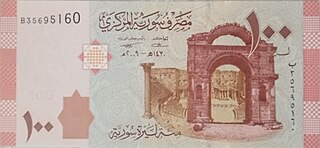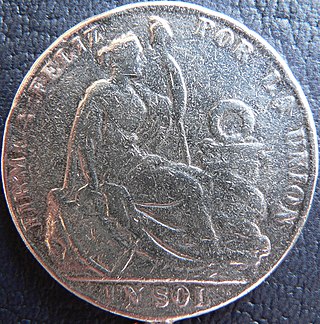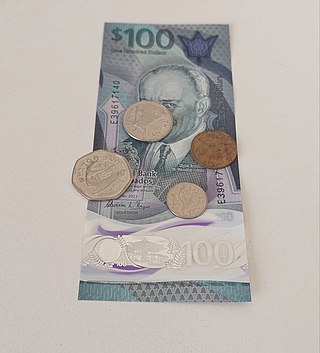
The CFP franc is the currency used in the French overseas collectivities of French Polynesia, New Caledonia, and Wallis and Futuna. The initials CFP originally stood for colonies françaises du Pacifique but since 2022 is officially Collectivités françaises du Pacifique. Its ISO 4217 currency code is XPF. The CFP franc is subdivided into 100 centimes, although there are no centime denominations. The currency is issued by Institut d'émission d'outre-mer (IEOM).

The franc, also commonly distinguished as the French franc (FF), was a currency of France. Between 1360 and 1641, it was the name of coins worth 1 livre tournois and it remained in common parlance as a term for this amount of money. It was reintroduced in 1795. After two centuries of inflation, it was redenominated in 1960, with each new franc (NF) being worth 100 old francs. The NF designation was continued for a few years before the currency returned to being simply the franc. Many French residents, though, continued to quote prices of especially expensive items in terms of the old franc, up to and even after the introduction of the euro in 2002. The French franc was a commonly held international reserve currency of reference in the 19th and 20th centuries. Between 1998 and 2002, the conversion of francs to euros was carried out at a rate of 6.55957 francs to 1 euro.

The Syrian pound or lira is the currency of Syria. It is issued by the Central Bank of Syria. The pound is nominally divided into 100 piastres, although piastre coins are no longer issued.

The sol, later sol de oro, was the currency of Peru between 1863 and 1985. It had the ISO 4217 currency code PES. It was subdivided into 10 dineros or 100 centavos. It also had two different superunits over its circulation life, the inca (1881–1882) and later the gold pound, both worth 10 soles.
The vatu is the currency of Vanuatu. It has no subdivisions.

The ariary is the currency of Madagascar. It is notionally subdivided into 5 iraimbilanja and is one of only two non-decimal currencies currently circulating. The names ariary and iraimbilanja derive from the pre-colonial currency, with ariary being the name for a silver dollar. Iraimbilanja means literally "one iron weight" and was the name of an old coin worth 1⁄5 of an ariary. However, as of May 2023, the unit is effectively obsolete since the iraimbilanja has practically no purchasing power, and the coins have fallen into disuse.

The Barbadian dollar is the official currency in Barbados. It is often abbreviated to international unofficial abbreviations in Barbados such as: B$, BD$ or the International vehicle registration code BDS$ is also commonly used, a currency code that is otherwise reserved for Bangladesh outside Barbados. As such the present Barbados dollar has the official ISO 4217 code of BB which matches the [dot] .bb Cc-TLD domain names classification for Barbados under ISO 3166, plus D for dollar in the foreign exchange market. The Barbadian dollar is considered a currency which can be divided into 100 cents, though the 1 cent coin is in the process of being phased out.

The Solomon Islands dollar is the currency of Solomon Islands since 1977. Its symbol is $, with SI$ used to differentiate it from other currencies also using the dollar sign. It is subdivided into 100 cents.

The Djiboutian franc is the currency of Djibouti. Its ISO 4217 currency code is DJF. Historically, it was subdivided into 100 centimes.
The franc is the official currency of Comoros. It is nominally subdivided into 100 centimes, although no centime denominations have ever been issued.

The piastre de commerce was the currency of French Indochina between 1887 and 1954. It was first used in 1885. It was subdivided into 100 cents, each of 2~6 sapèques.

The Cook Islands dollar was the former currency of the Cook Islands, which now uses the New Zealand dollar, although some physical cash issued for the Cook Islands dollar remains in use. The dollar was subdivided into 100 cents, with some older 50-cent coins carrying the denomination as "50 tene".

The pound was the currency of Fiji between 1873 and 1969. It was subdivided into 20 shillings, each of 12 pence.
The franc was the currency of Réunion until 1999. Before 1975, Réunion had its own franc, distinct from that of France. After 1975, the French franc circulated. Réunion now uses the euro. The Réunion franc was subdivided into 100 centimes.
The franc is the currency of New Caledonia and Wallis and Futuna, part of the CFP franc since 1945 and issued by the Institut d'émission d'outre-mer (IEOM) in Paris. It is subdivided into 100 centimes, although centime denominations are no longer in circulation.
The franc is the currency of French Polynesia, part of the CFP franc since 1945 and issued by the Institut d'émission d'outre-mer (IEOM) in Paris. It is subdivided into 100 centimes, although centime denominations are no longer in circulation.
The franc was the currency of French Guiana until 2002. The French franc circulated alongside banknotes issued specifically for French Guiana between 1888 and 1961 and notes issued for French Guiana, Guadeloupe and Martinique between 1961 and 1975.

The franc was the currency of Guadeloupe until 2002. It was subdivided into 100 centimes.

The franc was the currency of Martinique until 2002. It was subdivided into 100 centimes. The French franc circulated, alongside banknotes issued specifically for Martinique between 1855 and 1961 and notes issued for Martinique, French Guiana and Guadeloupe between 1961 and 1975.
The Saint Pierre and Miquelon franc was the currency of Saint Pierre and Miquelon during a short time.












